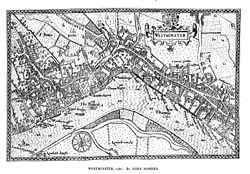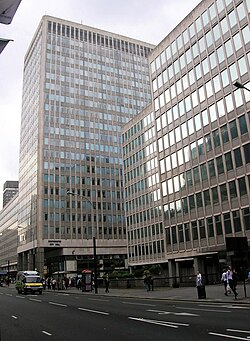| Westminster | |
|---|---|
 Westminster from Methodist Central Hall, with Westminster Abbey at right | |
Location within Greater London | |
| OS grid reference | TQ295795 |
| • Charing Cross | 0.58 mi (0.9 km) NEbE |
| London borough | |
| Ceremonial county | Greater London |
| Region | |
| Country | England |
| Sovereign state | United Kingdom |
| Post town | LONDON |
| Postcode district | SW1 |
| Dialling code | 020 |
| Police | Metropolitan |
| Fire | London |
| Ambulance | London |
| UK Parliament | |
| London Assembly | |
Westminster is the main settlement of the City of Westminster in Central London, England. It extends from the River Thames to Oxford Street and has many famous landmarks, including the Palace of Westminster, Buckingham Palace, Westminster Abbey, Westminster Cathedral, Trafalgar Square and much of the West End cultural centre including the entertainment precinct of West End theatre.
Contents
- Geography
- Physical geography
- Localities
- Open spaces
- Origins and administration
- Legendary origin
- Recorded origin
- Local government
- History
- Royal seat
- Medieval and Tudor
- Victorian divide
- Wider uses of the name
- Economy
- High Commissions
- Education
- Notable people
- References
- Notes
- Bibliography
- Further reading
- External links
The name (Old English : Westmynstre) [1] originated from the informal description of the abbey church and royal peculiar of St Peter's (Westminster Abbey), west of the City of London (until the English Reformation there was also an Eastminster abbey, on the other side of the City of London, in the East End of London). The abbey's origins date from between the 7th and 10th centuries, but it rose to national prominence when rebuilt by Edward the Confessor in the 11th century. With the development of the old palace alongside the abbey, Westminster has been the home of England's government since about 1200, and from 1707 the Government of the United Kingdom. In 1539, it became a city.
Westminster is often used as a metonym to refer to the Parliament of the United Kingdom, which sits in the Palace of Westminster.











